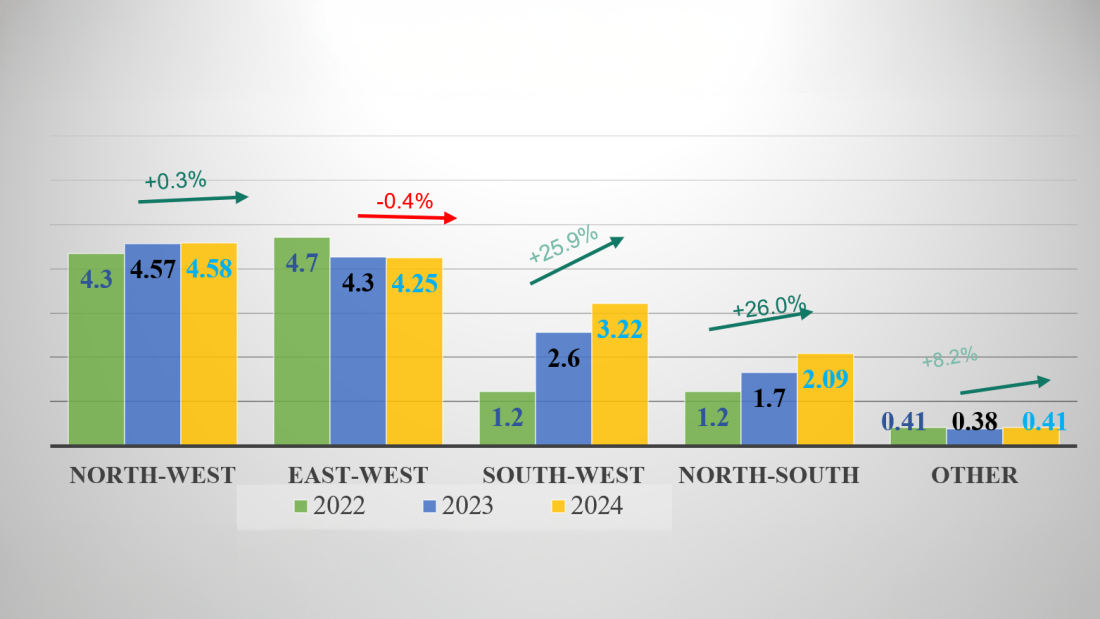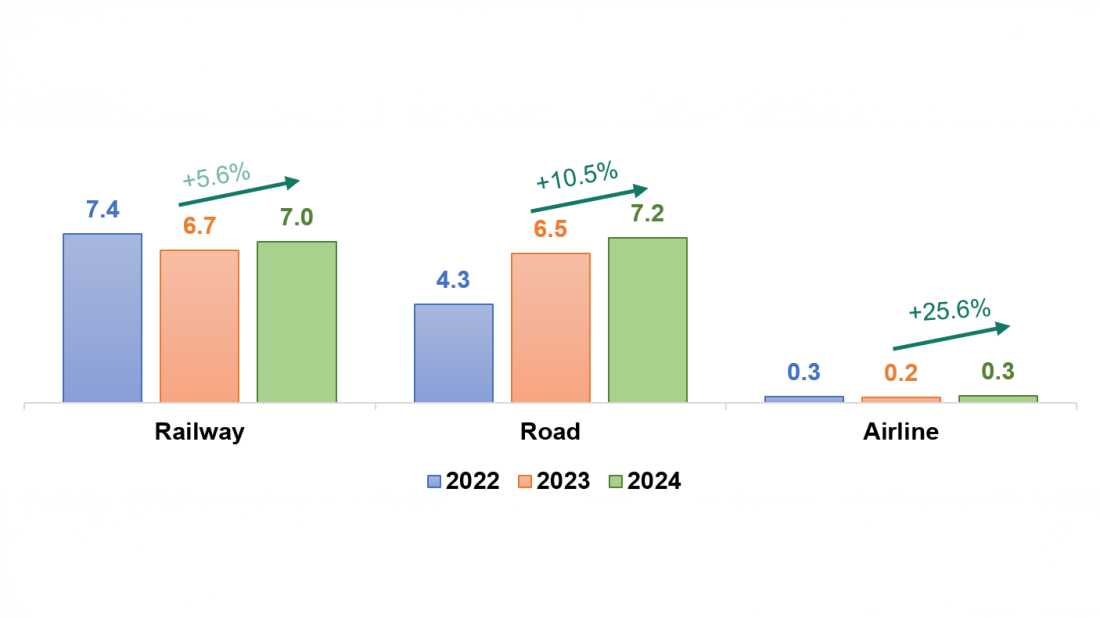NATO unveils Eastern Sentry to bolster defenses after Russian drone incursions
NATO has launched a new operation, Eastern Sentry, to strengthen defenses along its eastern flank following Russian drone incursions into Polish airsp...
The AnewZ Opinion section provides a platform for independent voices to share expert perspectives on global and regional issues. The views expressed are solely those of the authors and do not represent the official position of AnewZ
Global integration processes have become an integral part of everyday life. Recently, as a result of further intensification of processes, integration tools, especially transport services, have become of great importance in economic progress. Global and regional integration relies on stable trade, facilitated by transport relations. In this sense, transport and transit services and relations have become crucial for the sustainable and dynamic progress of national economies, becoming the key means of access to foreign markets and integration into the global space.
The breadth of international transport relations, being a participant in international transport corridors, promises special advantages and long-term dividends to national states. Consequently, the study of the potential opportunities of international transport corridors is relevant at all times.
The formation of international transport corridors is a modern-day challenge
Dynamic progress of nations hinges on several key factors. Access to foreign markets, active participation in global socio-economic processes, and the protection of national interests and security are all main drivers of state progress. Currently, thanks to the development of ICT, the movement of goods and services has sharply risen. It is as if states are competing to have a greater share in world trade, to produce more and more diverse products for the world market. Economic theory also posits that the export of a wider array of end products indicates a country’s level of development.
From this perspective, the competition for a greater share of the global market is natural. The main driving force behind this rivalry is transport relations. In other words, transport networks serve as the foundation for access to foreign markets, which in turn is vital for the sustainable and dynamic progress of nation-states.
Azerbaijan's transport and transit capabilities cover all directions
In terms of geographical position and modern infrastructure, it is currently impossible to implement any regional project without Azerbaijan’s participation.
Over the years, Azerbaijan has systematically developed key infrastructure, including the creation of the Alat Free Economic Zone, spanning approximately 400 hectares. The country has adopted a comprehensive approach to different modes of transport and established institutions like the Coordination Council for Transit Transportation and the Azerbaijan Transport and Communication Holding, which oversees the entire transport sector.
These efforts have been supported by the successful implementation of various state programs, infrastructure projects, and a national software-based transport management system.
Thus, Azerbaijan plays a leading role in international transport networks and transit cooperation. Today, transit is being carried out in the East-West and North-South directions, in addition to the North-West and South-West directions.
In May 2024, the works on the Baku-Tbilisi-Kars railway were completed, making it fully operational. This development increased the annual throughput capacity from one million tons to five million tons. This line, called the Iron Silk Road, is of particular importance for transportation in the East-West directions.
Statistical indicators from 2024 show an increase in transit transportation in all directions. According to data from the State Customs Committee, 97 percent of total transit passed through four main corridors, including East-West, North-West, South-West and North-South. Among these, 32% of transit traffic was carried out in the North-West direction, 29% in the East-West direction, 22% in the South-West direction, and 14% in the North-South direction.
As mentioned above, with the exception of a 0.4% decrease in the East-West corridor, dynamic growth was achieved in transportation on other corridors. The decrease on the East-West corridor is mainly due to the repair of the Baku-Tbilisi-Kars railway line, which was completed in May 2024.
Volume of cargo transportation on international corridors, million tons (for 2022-2024)

Source: State Customs Committee
In the distribution of transit cargo transported in international corridors by transport modes, highways accounted for 50%, railways for 48%, and air transport for the remaining 2%. While water transport contributes to transit flows, cargo is generally accounted for under road or rail transport, as it is these modes that handle the movement to and from ports.
In terms of total transit cargo volume, 12 million tons were transported in 2022, 13.4 million tons in 2023, and 14.5 million tons in 2024. The breakdown by year and mode of transport is as follows.
Volume of transit cargo transportation by types of transport,million tons (for 2022-2024)

Source: State Customs Committee
The current performance of international transport corridors, and their potential, underscores the need for continued efforts in this area. Given that the figures above represent only a fraction of the corridors' full capacity, it is evident that their prospects are both broader and longer term.
Along with the statistical trends, institutional and conceptual decisions further strengthen Azerbaijan's position. One element, namely the implementation of software-based management, yielded concrete results, complementing the overall strategy.
The opening of the Zangezur corridor will further expand transport and transit opportunities
This project serves as a transport bridge between Nakhchivan and other regions of Azerbaijan, while also linking China and Central Asian countries to the transit and transport line of Europe through Azerbaijan and Türkiye. As for Azerbaijan, the Zangezur corridor turns the country into an important economic partner bridging the East and the West. Furthermore, Nakhchivan, an integral part of Azerbaijan, becomes effectively integrated into global transport architecture. The Zangezur corridor will also boost the volume of transportation from China to Europe, in addition to diversifying transportation directions.
Preliminary estimates indicate that the opening of the Zangezur corridor will increase the throughput capacity of the Middle Corridor by 10-12 million tons per year. The construction of the Osmanli-Horadiz-Aghband-Nakhchivan railway line, a crucial link of the corridor, is ongoing and the project is expected to be completed soon. Meanwhile, the Turkish side plans to complete and put into operation the 224 km Kars-Iğdır-Aralık-Dilucu railway line within 4-5 years. The construction of this connection, as a continuation of the Osmanli-Horadiz-Aghband-Nakhchivan railway line, will further strengthen Azerbaijan's position as a transport and transit junction.
During this period, it is planned to reconstruct the 150 km of existing road in Nakhchivan and build about 27 km of road from scratch, creating an alternative route for handling transit cargo through Azerbaijan.
Global challenges for transport and transit services
As mentioned earlier, transportation between Asia and Europe is carried out through the East-West and North-South transport corridors. Simultaneously, North-West and South-West transportation - developed on the basis of these corridors - is already a reality and there are concrete statistical results in this regard.
However, in modern times, the Middle Corridor has gained attention due to its strategic advantages. The corridor is widely regarded as a promising route by both individual organizations and states. The UN Special Program SPECA, the ADB (Asian Development Bank), CAREC, China's "One Belt, One Road" project, the Organization of Turkic States, etc. recognize the Middle Corridor as strategically important.
The Middle Corridor accounts for only 3-5% of the cargo transported between China and Europe. However, due to the disruption in the Northern Corridor and the new regional geopolitical and geoeconomic realities, projections suggest that the volume of transportation via the Middle Corridor will increase by at least 15-20%.
At the same time, economic uncertainty, particularly the imposition of high tariffs by the United States on products imported from various countries, necessitates the access of Chinese products -the world's largest manufacturing center - to new markets. In this situation, the movement of Chinese products to the Gulf countries, the European market, and African countries will intensify even more. Ultimately, this will lead to an increase in cargo volume and turnover.
Therefore, the increase in transportation via the Middle Corridor is a reality, and it is necessary to form an infrastructure enabling the countries along the corridor to process the increasing cargo volume in accordance with existing standards. Continuous improvement of infrastructure and institutional arrangements is one of the main challenges facing every international transport route, including the Middle Corridor.
Conclusion
Based on the conducted studies, as well as reports and analyses of the World Bank, ADB, CAREC, and other organizations, the following points need to be considered:
Thus, considering the above-mentioned factors can create conditions for further increase in transportation volume along international transport corridors, simplification of transit transportation procedures, increase cargo attractiveness, turning transit services into one of the main sources of income for national budgets. Undoubtedly, transportation requirements are a changing and developing demand depending on the processes and changes taking place in society and industry. Therefore, in addition to taking into account the above, both the flexibility of processes and the improvement of transportation means and infrastructure provision along the corridors should be continuously implemented.
Agil Mahiyaddin Asadov
Head of Division, Doctor of Economics, Center for Analysis of Economic Reforms and Communication
Abdulrahim Abdulrahman Dadashov
Head of Sector, Doctor of Philosophy in Economics, Center for Analysis of Economic Reforms and Communication
AnewZ has learned that India has once again blocked Azerbaijan’s application for full membership in the Shanghai Cooperation Organisation, while Pakistan’s recent decision to consider diplomatic relations with Armenia has been coordinated with Baku as part of Azerbaijan’s peace agenda.
A day of mourning has been declared in Portugal to pay respect to victims who lost their lives in the Lisbon Funicular crash which happened on Wednesday evening.
The UK is gearing up for Exercise Pegasus 2025, its largest pandemic readiness test since COVID-19. Running from September to November, this full-scale simulation will challenge the country's response to a fast-moving respiratory outbreak.
A Polish Air Force pilot was killed on Thursday when an F-16 fighter jet crashed during a training flight ahead of the 2025 Radom International Air Show.
On 2 September, spot gold briefly broke through the historic threshold of $3,500 an ounce, before settling just under that level at $3,494. This rally not only eclipsed the previous peak set in April but also cemented gold’s position as one of the best-performing assets of 2025.
When I first thought about the idea of a European army, the phrase sounded a little bit like a political catchphrase, something that politicians use without actually having a plan in the background.
Under the decisive and empowering leadership of President Ilham Aliyev, Azerbaijan has a remarkable trajectory in world politics.
The Shanghai Cooperation Organization (SCO) summit in Tianjin has drawn unprecedented attention. With the largest gathering in its history, the SCO now stands as one of the most significant multilateral platforms in Eurasia.
President Ilham Aliyev’s working visit to Beijing on 30 August 2025 was primarily to attend the Shanghai Cooperation Organization (SCO) Summit, and his meeting with Chinese President Xi Jinping took place on the sidelines of this multilateral gathering.
You can download the AnewZ application from Play Store and the App Store.

What is your opinion on this topic?
Leave the first comment